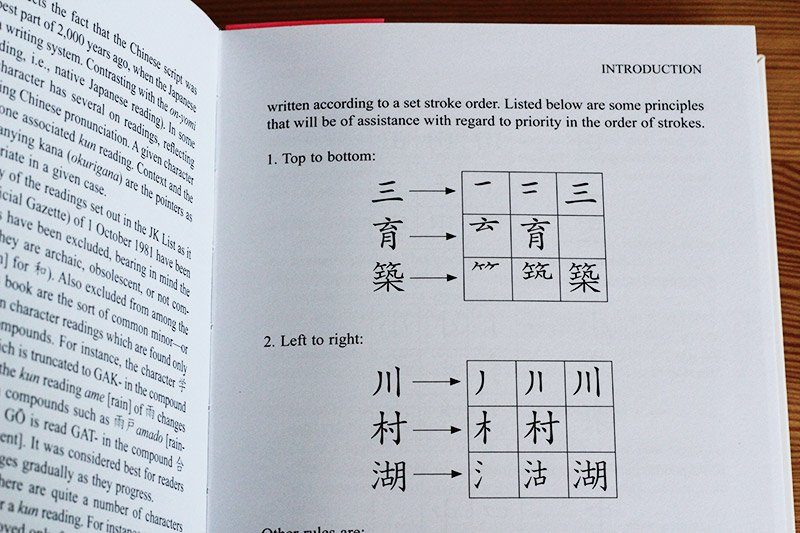I like reading, I like looking through lists, and also I like kanji (and no I'm not lying). So when Tuttle publishing sent us A Guide to Reading and Writing Japanese, I agreed to dig into it. Unfortunately, there wasn't much to bite into. I had heard of the original edition being useful for professors and students back in the day, but nothing about this one. Now I know why.
Kanji ABCs

It explains how kanji are made up into words, that there are on'yomi and kun'yomi readings, what that means and why, and how stroke order works. But that's all in about 3 pages or so and then it jumps into two big lists.
When you look at an entry you'll see this:

It's the basics. That's what this is for. You will learn the reading(s), meaning, and see two or three example words that it's used in. That's it. That's the book.
But it is not a dictionary. Well, not really. Because it only has kanji, the words are only listed under them as a supplement. You can't really use it to look things up like a normal dictionary because of how the lists are organized.
Whose List is it Anyway?
Okay, so this book has been around for a while. The original edition was published in 1959, so it has been around the block, and it has helped a lot of people. It has also been evolving throughout the decades to cater to the changes made in kanji popularity and usage. This is the fourth edition, after all.

This particular edition includes two different lists of kanji. The first being "Essential Characters," which follows the MEXT six grade system. MEXT is short for Monbu Kagaku Shō 文部科学省 which is called the "Ministry of Education, Culture, Sports, Science and Technology" in English. But that's crazy long. Everyone just calls them MEXT. As you've probably guessed, their lists are the real deal. These are the characters kids from grades 1-6 in Japanese schools are supposed to learn. You may have heard of it referred to as Kyōiku kanji 教育漢字 , literally "education kanji." It is a great list to use if you want to start learning kanji.
The second list is made up of "General-Use Characters," also known as the Jōyō kanji 常用漢字. As you've probably guessed, all of the "Essential Characters" in section one show up here too. And they only include on'yomi, kun'yomi, and meanings for these. But that's it. That is even less than the first list.
Useful or Useless?

My main question when going through these lists is why even include the repeating kanji? Why take the space to print them again, referring to the original entry, when that could have been where they included the same information included in the "in depth" entries for the "essential" list? Honestly, it seems like they just didn't want to take the time to sort them out. I understand wanting to include both categories, but it feels messy. It feels rushed.
Another big problem is that you can look up any and all of the information in this book in seconds with sites like Jisho, Tangorin, even good old Jim Breen's. I have more, but you get the point. Yes, it's a cute book. It's actually really nice quality for a semi-soft cover, but we're getting to a point in time where this kind of book is becoming obsolete. Not to mention all the free phone apps that have kanji lookups. Jisho includes stroke order with animation now. So even that's covered in seconds online.
"What about the MEXT list?" you ask. Wouldn't this book be great for making an Anki deck? Well, sorry (not sorry) but that's public domain and it's all online for free. The Jōyō kanji list is online too. If you want to make a deck, please use the links provided and don't go through each kanji in this book individually.
If you really want to learn and practice stroke order, I can see why it would be appealing. However, leaning how stroke order works, learning the basic patterns, is more than enough. Once you have the basics down you'll be able to write any kanji you see without wondering if you're doing it right.
A Guide to Reading and Writing Japanese - Verdict

If you love having things in paper, in physical form, and you really want to rub your hands all over this thing, then please, buy it. If you really like looking at pretty kanji lists, please, you too, click that link down there. Buy this book and put it on your shelf. But I really can't see why anyone would use it more than once or twice out of buyer's guilt.
I can't strip it of all merit. Sometimes you don't have internet or phone service. But this isn't a dictionary, so I don't see why you would pull it out in those moments. It's best for learning how to write kanji away from computers and phones. But it could be a good beginner's book for people to realize that they do want to learn more about kanji. So if that's what you're looking for, pick it up. Otherwise, I wouldn't bother.
Kristen’s Review
I don’t think I could, in good conscience, recommend this book to anyone these days. If you have a computer, all of this information is already out there for free. Just learn some google-fu and you’ll be alright.
